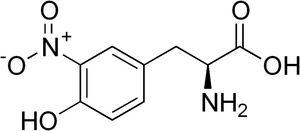Nitrotyrosine: Difference between revisions
Eric Martz (talk | contribs) No edit summary |
Eric Martz (talk | contribs) No edit summary |
||
| (3 intermediate revisions by the same user not shown) | |||
| Line 2: | Line 2: | ||
Nitrotyrosine<ref>[[User:Eric Martz]] wishes to thank [http://www.cancer.ucla.edu/index.aspx?page=645&recordid=338 Hermes J. Garbán] for bringing nitrotyrosine to his attention.</ref> results from the post-translational modification of the [[Amino_Acids|standard amino acid]] tyrosine. Reactive nitrogen compounds produced in inflammation are typically responsible. Nitrosylation of tyrosine tends to inactivate enzymes. | Nitrotyrosine<ref>[[User:Eric Martz]] wishes to thank [http://www.cancer.ucla.edu/index.aspx?page=645&recordid=338 Hermes J. Garbán] for bringing nitrotyrosine to his attention.</ref> results from the post-translational modification of the [[Amino_Acids|standard amino acid]] tyrosine. Reactive nitrogen compounds produced in inflammation are typically responsible. Nitrosylation of tyrosine tends to inactivate enzymes. | ||
In March, 2011, there are 13 entries in the [[PDB]] containing coordinates for 3-nitrotyrosine (meta-nitro-tyrosine), with the [[ | In March, 2011, there are 13 entries in the [[PDB]] containing coordinates for 3-nitrotyrosine (meta-nitro-tyrosine), with the [[Non-Standard_Residues|compound ID]] '''NIY'''. These include six sequence-distinct proteins, represented by ribonucleotide reductase [[2xof]] and [[2xap]], laccase [[3div]], Human Manganese Superoxide Dismutase [[2adp]], Human Glutathione Reductase [[1k4q]], and bovine Cu,Zn superoxide dismutase [[1sda]]. Not surprisingly, the NO<sub>2</sub> adduct, being very hydrophilic, is often on the surface of the protein. | ||
{{Clear}} | {{Clear}} | ||
<Structure size='450' frame='true' align='right' caption=' | <Structure size='450' frame='true' align='right' caption='' scene='Sandbox7_Eric_Martz/Cartoon/1' /> | ||
scene='Sandbox7_Eric_Martz/Cartoon/1' /> | One interesting case is Human <font color="#00c000">'''Manganese'''</font> Superoxide Dismutase, for which structures are available for the wild type [[2adq]], shown at right (<scene name='Sandbox7_Eric_Martz/Cartoon/1'>restore initial scene</scene>), and the nitrated form, [[2adp]]. In this structure, <font color="#00c000">'''Mn<sup>++</sup>'''</font> is <scene name='Sandbox7_Eric_Martz/Cartoon/2'>buried</scene>. The <font color="#00c000">'''Mn<sup>++</sup>'''</font> is | ||
One interesting case is Human <font color="#00c000">'''Manganese'''</font> Superoxide Dismutase, for which structures are available for the wild type [[2adq]], shown at right (<scene name='Sandbox7_Eric_Martz/Cartoon/1'>restore initial scene</scene>), and the nitrated form, [[2adp]]. In this structure, <font color="#00c000">'''Mn<sup>++</sup>'''</font> is <scene name='Sandbox7_Eric_Martz/Cartoon/2'>buried</scene>. The | |||
<scene name='Sandbox7_Eric_Martz/Mn_contacts/1'>caged</scene> by four histidine <font color="#3050F8">'''nitrogens'''</font>, one aspartate <font color="#ff0d0d">'''oxygen'''</font>, and one <font color="magenta">'''water'''</font>. Tyrosine 34 is nearby (5.2 Ångstroms), but not near enough to be interacting with the <font color="#00c000">'''Mn<sup>++</sup>'''</font> or its cage. | <scene name='Sandbox7_Eric_Martz/Mn_contacts/1'>caged</scene> by four histidine <font color="#3050F8">'''nitrogens'''</font>, one aspartate <font color="#ff0d0d">'''oxygen'''</font>, and one <font color="magenta">'''water'''</font>. Tyrosine 34 is nearby (5.2 Ångstroms), but not near enough to be interacting with the <font color="#00c000">'''Mn<sup>++</sup>'''</font> or its cage. | ||
<scene name='Sandbox7_Eric_Martz/Contacts_to_nitrotyrosine/1'>Nitrosylation of tyrosine 34</scene> extends it towards the <font color="#00c000">'''Mn<sup>++</sup>'''</font>. The partially negatively charged <font color="#ff0d0d">'''oxygens'''</font> in the NO<sub>2</sub> are 3.6-3.8 Å from the electron-hungry <font color="#00c000">'''Mn<sup>++</sup>'''</font>. <scene name='Sandbox7_Eric_Martz/Aligned_pre_and_post_nitro/2'>Nitrosylation pushes the tyrosine ring</scene> slightly farther from the <font color="#00c000">'''Mn<sup>++</sup>'''</font>, but causes no other significant conformational changes<ref>[[DeepView]] was used to align all atoms of the three Mn-coordinating histidines. In the resulting file [[Image:2adq-2adp-3hisaln.pdb]], 2adq is model 1, and 2adp is model 2.</ref>. The authors<ref>PMID: 16443160</ref> conclude | <scene name='Sandbox7_Eric_Martz/Contacts_to_nitrotyrosine/1'>Nitrosylation of tyrosine 34</scene> extends it towards the <font color="#00c000">'''Mn<sup>++</sup>'''</font>. The partially negatively charged <font color="#ff0d0d">'''oxygens'''</font> in the NO<sub>2</sub> are 3.6-3.8 Å from the electron-hungry <font color="#00c000">'''Mn<sup>++</sup>'''</font>. <scene name='Sandbox7_Eric_Martz/Aligned_pre_and_post_nitro/2'>Nitrosylation pushes the tyrosine ring</scene> slightly farther from the <font color="#00c000">'''Mn<sup>++</sup>'''</font>, but causes no other significant conformational changes<ref>[[DeepView]] was used to align all atoms of the three Mn-coordinating histidines. In the resulting file [[Image:2adq-2adp-3hisaln.pdb]], 2adq is model 1, and 2adp is model 2.</ref>. The authors<ref>PMID: 16443160</ref> conclude | ||
Latest revision as of 23:35, 19 March 2011

Nitrotyrosine[1] results from the post-translational modification of the standard amino acid tyrosine. Reactive nitrogen compounds produced in inflammation are typically responsible. Nitrosylation of tyrosine tends to inactivate enzymes.
In March, 2011, there are 13 entries in the PDB containing coordinates for 3-nitrotyrosine (meta-nitro-tyrosine), with the compound ID NIY. These include six sequence-distinct proteins, represented by ribonucleotide reductase 2xof and 2xap, laccase 3div, Human Manganese Superoxide Dismutase 2adp, Human Glutathione Reductase 1k4q, and bovine Cu,Zn superoxide dismutase 1sda. Not surprisingly, the NO2 adduct, being very hydrophilic, is often on the surface of the protein.
|
One interesting case is Human Manganese Superoxide Dismutase, for which structures are available for the wild type 2adq, shown at right (), and the nitrated form, 2adp. In this structure, Mn++ is . The Mn++ is by four histidine nitrogens, one aspartate oxygen, and one water. Tyrosine 34 is nearby (5.2 Ångstroms), but not near enough to be interacting with the Mn++ or its cage. extends it towards the Mn++. The partially negatively charged oxygens in the NO2 are 3.6-3.8 Å from the electron-hungry Mn++. slightly farther from the Mn++, but causes no other significant conformational changes[2]. The authors[3] conclude
"Inhibition of catalysis can be attributed to a steric effect of 3-nitrotyrosine 34 that impedes substrate access and binding, and alteration of the hydrogen-bond network that supports proton transfer in catalysis. It is also possible that an electrostatic effect of the nitro group has altered the finely tuned redox potential necessary for efficient catalysis, although the redox potential of nitrated MnSOD has not been measured."
See AlsoSee Also
- Nitrotyrosine in Wikipedia.
NotesNotes
- ↑ User:Eric Martz wishes to thank Hermes J. Garbán for bringing nitrotyrosine to his attention.
- ↑ DeepView was used to align all atoms of the three Mn-coordinating histidines. In the resulting file File:2adq-2adp-3hisaln.pdb, 2adq is model 1, and 2adp is model 2.
- ↑ Quint P, Reutzel R, Mikulski R, McKenna R, Silverman DN. Crystal structure of nitrated human manganese superoxide dismutase: mechanism of inactivation. Free Radic Biol Med. 2006 Feb 1;40(3):453-8. Epub 2005 Nov 9. PMID:16443160 doi:10.1016/j.freeradbiomed.2005.08.045